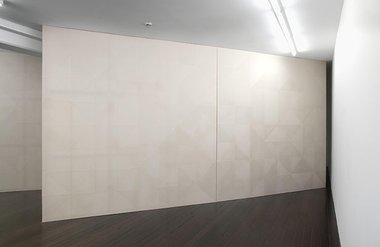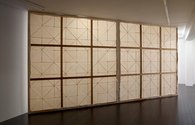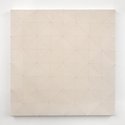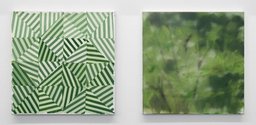John Hurrell – 16 July, 2012
Where you stand in relation to the illumination source affects the way you see the light raking the surface of the stitched-together triangles, and the shadows cast by the supporting cedar struts on the back of the taut material. Plus when you move around to peer behind them, you can see that the stitched denim portions have ruffled edges projecting out from the sewn joins at right angles to the main plane. The mood changes to take on a delicate fragility and decorative whimsy.
In some of his more recent Auckland shows - within his own studio, at Te Tuhi, or else at Hopkinson Cundy - Andrew Barber has exploited his formidable DIY skills by presenting very large stretchers as forms of planar architecture: either freestanding and extending upwards from floor to ceiling, attached firmly to the ceiling between beams, or covering walls and extending out from corners horizontally.
He has also been exhibiting painting experiments using light denim as a support, following the parallel grooves of this fabric as a guide for the direction of painted lines. This interest in the grain of the weave has developed into stitched canvas triangles that as a painted surface feature clashing directional vectors - randomly organised.
Barber’s current exhibition subsequently presents butted together stretchers holding unpainted patchwork canvases as freestanding walls - two long thin ones that converge at an angle but don’t touch. They refer to tall hedges (like windbreaks) in an imaginary landscape, the tradition from which his painting practice comes. The way too they obstruct the gallery space is witty in that you ‘hedge your bets’ in turning left or right if you wish to go to the office. Only one way succeeds: the opposite side is in darkness. Overall from the front, the walls seem to be a combination of Robert Irwin scrim works and a large monochromic Amish quilt.
As an installation, appreciating the light entering the space via the Cross Street windows from early morning, or from the ceiling’s fluorescent tubes in late afternoon, is crucial. Where you stand in relation to the illumination source affects the way you see firstly the light raking the surface of the stitched-together triangles, and secondly the shadows cast by the supporting cedar struts on the back of the taut material. Plus when you move around to peer behind them, you can see that the stitched denim portions have ruffled edges projecting out from the sewn joins at right angles to the main plane, as if edges of a cardboard tray, or paper trimming around a cake. The mood changes to take on a delicate fragility and decorative whimsy.
As with the related exhibition of Jeena Shin down the road at Two Rooms, the weather conditions (especially cloud cover) and time of day has consequences for examining the work’s manipulated surface - its triangular configurations. Harsh sunlight pouring in the windows affects the space differently from the soft glare of overcast weather, or the ceiling based illumination of fluorescent tubes. With the high walls towering over your own vertical body, certain spaces you squeeze through, and the presence of the constantly darker corner tucked well away from the windows, this is a very interesting architectural exhibition to visit, walk around, and mentally and bodily engage with.
John Hurrell







 Advertising in this column
Advertising in this column Two Rooms presents a program of residencies and projects
Two Rooms presents a program of residencies and projects



This Discussion has 0 comments.
Comment
Participate
Register to Participate.
Sign in
Sign in to an existing account.